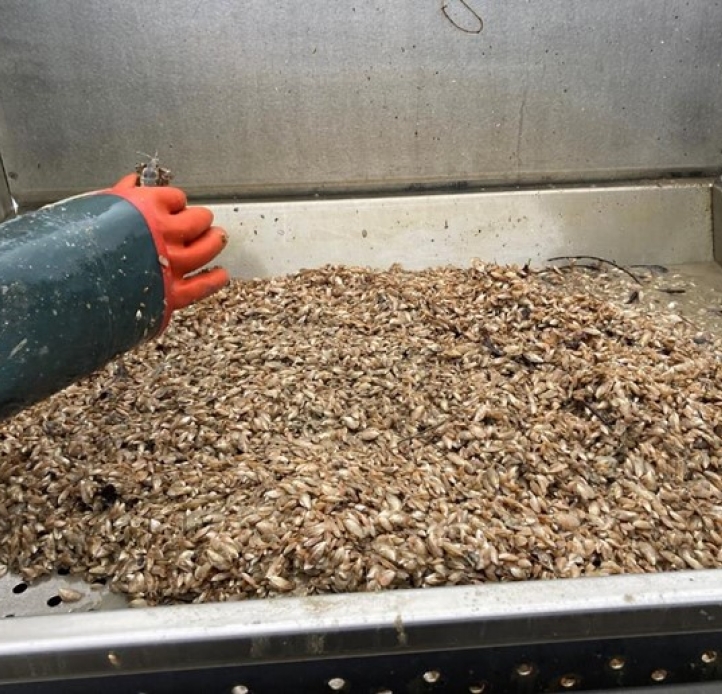
Great Lakes Center Newsletter: Issue 26
May 6, 2025
This issue features a sabbatical in Switzerland, graduate research training native crayfish to outcompete invasive crayfish, water gardens and invasive plants, and a recent paper on 100 years of mollusc research in Oneida Lake. We introduce our newest research technician and a new look for our website. We also have a guest article from one of our GLC affiliates and an undergraduate student.
Working in Switzerland
by Lyuba Burlakova and Alexander Karatayev
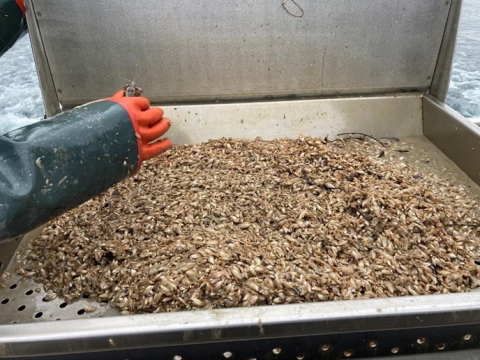
Over the past six months, we’ve had the pleasure of spending our sabbatical at Eawag, the Swiss Federal Institute of Aquatic Science and Technology – one of the world’s leading centers for water research. We’ve been collaborating with scientists at Eawag for the past five years, and together we’ve already published three papers focused on predicting the population dynamics and ecological impact of quagga mussels in deep, pre-alpine lakes in Europe. These predictions draw on insights we’ve gained over more than 30 years of research, particularly from the past decade, supported by our ongoing grant “Great Lakes Biology Monitoring Program” funded by the U.S. EPA. This partnership with Eawag’s experts is expected to lead to several more high-impact publications. Since quagga mussels are rapidly spreading across both Europe and North America, we anticipate strong interest in this work, which will help raise the profile of our center and university.
We are meeting with our international collaborators to present our research, discuss joint projects and publications, and collect data for analysis. So far, we’ve made 3 presentations at meetings and seminars in Eawag and at the International Commission for the Protection of the Waters of Lake Geneva (CIPEL), 2 seminars in Portugal at Research Centre in Biodiversity and Genetic Resources (CIBIO), and a presentation about quagga mussels at EDIA, a public company that manages the Alqueva Multipurpose Project. While it’s officially called a sabbatical, we’ve continued to fulfill all of our responsibilities at Buffalo State throughout this period, conducting our routine business, and meeting weekly with employees to fulfill Sasha’s obligations as the Center Director and Lyuba’s as PI of the grant. Learn more about it in Photos from Sabbatical.
Crayfish Fight Club: Enhancing native species behavior to outcompete invasive crayfish
by Emily Klimczak, GLES M.A. graduate student
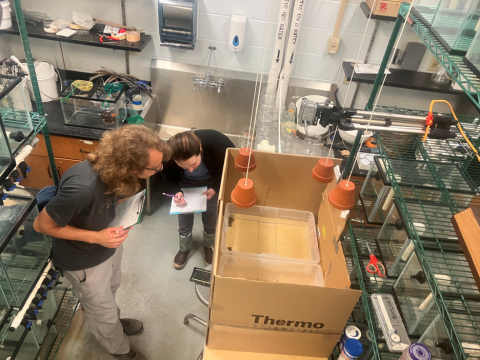
Invasive species are a major threat to the survival of native species within ecosystems. Within the past few years, a relatively new invasive species has been discovered in Western New York: the red swamp crayfish (Procambarus clarkii). While on-going efforts are being conducted to manage and stop the spread of red swamp crayfish, new management techniques may be required to stop the invasion. Emily Klimczak, a graduate student, along with her advisor Dr. Chris Pennuto, are researching techniques that enhance the behavior of native species in hopes they will be able to outcompete the red swamp crayfish for resources.
Emily, with help from undergraduate assistant Nick Hahn, has been training native big water crayfish (Cambarus robustus) using the winner-loser effect, a phenomenon where individuals that win competitions have a higher probability of winning future competitions, to enhance their experience of winning competition interactions. Crayfish are trained by matching larger big water crayfish against smaller big water crayfish, leading the bigger crayfish to win subsequent interactions. Ultimately, she is determining if multiple wins against smaller crayfish of the same species will translate into successful interactions against the invasive red swamp crayfish in a set of trials. Overall, 76 trials were performed including 37 non-food trials and 39 food competition trials. Of the 37 non-food trials, 20 were performed with trained big water crayfish and 17 were performed with random, non-trained crayfish. Of the 39 food competition trials, 18 were performed with trained big water crayfish and 21 were performed with random, non-trained big water crayfish. The only difference between the two trial types was the addition of a single squid pellet used as a food resource.
While training native crayfish using the winner-loser effect did not seem to affect the outcome of trials, the results are still surprising. In non-food trials, the native big water crayfish was observed winning 78% of the interactions. Without food present, big water crayfish, based on behavior displayed, were more aggressive than the invasive red swamp crayfish. In contrast, when food was added to the trials, red swamp crayfish dominated by winning 95% of the interactions, ultimately getting to the food first. These results suggest that red swamp crayfish are very food motivated and, because of their higher growth rates, could have higher metabolism and elevated hunger. The ability of red swamp crayfish to dominate competitions for food resources likely contributes to their success as an invader. Further investigations to understand the underlying mechanisms that drive high food motivation in red swamp crayfish may be used to develop future management tools against this invasive crayfish.
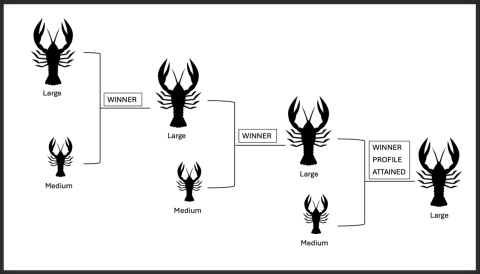
interactions the large crayfish is considered to have acquired a winner profile.
Water garden escape artists
by Rachel Taylor
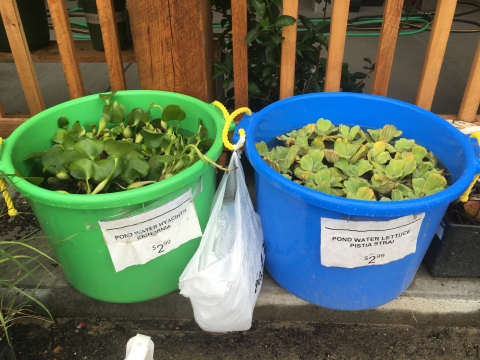
A water garden is a wonderful way to transform your outdoor space into a tranquil retreat. Whether you are a seasoned water gardener or if you’re creating a water garden for the first time, it’s important to consider what types of plants you choose as you head out to the nurseries this spring. Unfortunately, some plants available to water gardeners are invasive species. Not only can these species take over your garden, but they can also cause a lot of harm if they escape to other bodies of water. You can do your part to help protect our aquatic ecosystems by keeping your water garden away from other waterways and flood-prone areas, avoiding or properly disposing of invasive plants and cultivating native or non-invasive plants in your water garden.
There are many ways aquatic invasive plants can escape water gardens and spread into our waterways. Storms or flooding can wash invasive plants or their propagules (e.g., seeds) into nearby waterbodies. Wildlife, such as birds or mammals, can transport aquatic invasive plants into nearby or distant waterbodies. For example, when visiting a water garden, the invasive plant or their propagules could adhere to their feathers, fur, or feet and get carried to new locations. Aquatic invasive plants may even be intentionally released by people who are unaware of the negative impacts that will result. Once in the wild, aquatic invasive plant species change how an aquatic ecosystem functions. They can reduce the food and suitable habitat available to fish and other wildlife, they impede recreation, and impact tourism and our local economy.
Water soldiers (Stratiotes aloides) is a prime example of this. Originally sold as an ornamental in Ontario, Canada, this aquatic invasive plant invaded Trent River in 2008, most likely as an escapee from its use in water gardens. Ontario’s Trent-Severn Waterway contains the largest and one of the only known populations of water soldiers in North America. While it is a prohibited species in Ontario, it is imperative to increase awareness of water soldiers to prevent its spread to new locations, such as in New York State, where there are currently no regulations on the sale or use of this species. Water soldiers is a submerged aquatic plant, but during the summer months it becomes buoyant and looks like the top of a pineapple. It forms dense floating mats, which crowd out native plants and can impede recreational activities. Additionally, its sharp serrated leaf edges can cut swimmers or people who handle it (Invasive Species Centre, 2024).
Water soldiers isn’t the only aquatic invasive plant you might find for sale at a nursery. Floating invasive plants, such as water hyacinth (Oshuna crassipes) and water lettuce (Pistia stratiotes) are also sold for use in water gardens. Both can reproduce rapidly and cover the surface of your water garden, creating habitat for mosquitos while also blocking sunlight necessary to support healthy native plants. While these species are limited by sustained cold winter temperatures, several populations have been observed in New York’s waterways and they may be reproducing. Another invasive plant that might be in your water garden is yellow floating heart (Nymphoides peltata). This plant impacts water gardens and waterbodies similarly to the species previously mentioned, but unlike the others, yellow floating heart is a prohibited species in New York State and won’t be sold at nurseries.
Originally appeared in the WNY PRISM Spring Newsletter (PDF). Republished with permission. All photos credited to WNY PRISM except where otherwise noted.
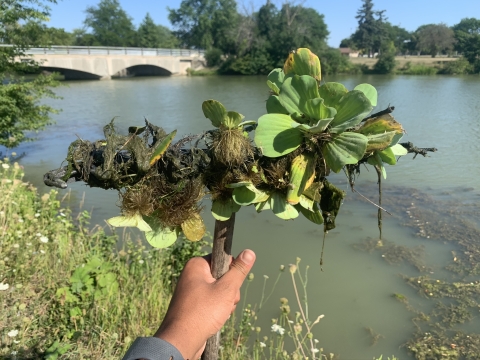
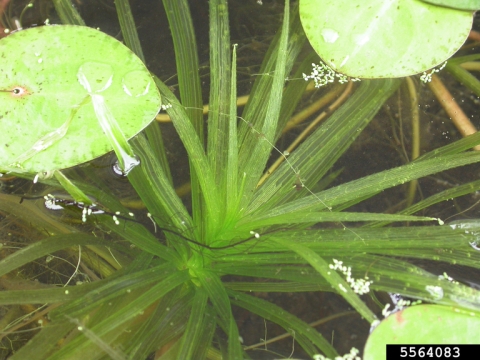
Edition 3, USDA APHIS PPQ, Bugwood.org.
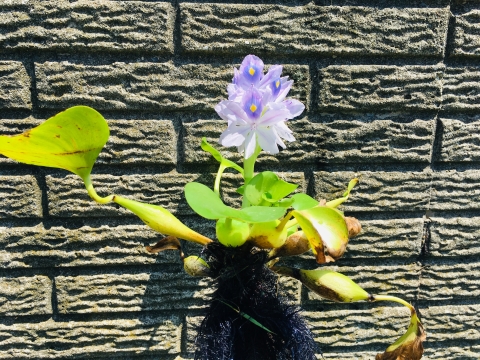
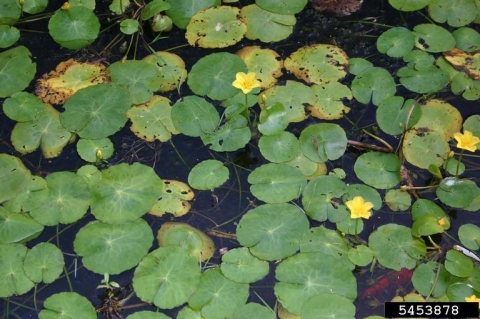
Connecticut, Bugwood.org.
GLC updates
by Brian Haas and Kit Hastings
New Research Technician
Ben Szczygiel is our new research technician at the Field Station. He is a former graduate student who worked on the second phase of the Emerald Shiner Project in the Upper Niagara River. Ben worked at Purdue and operated a trio of data buoys in Lake Michigan for the past 3 years. We are happy to have him back at the Great Lakes Center and look forward to working with him on a variety of projects.
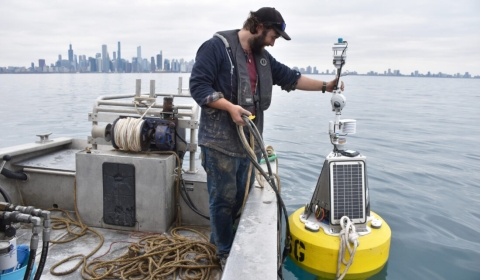
Collaborations
The Social Work Department visited the Field Station this spring as part of the Great Lakes Center’s initiative to expand its multidisciplinary collaborations. The tour and meeting were productive, and many opportunities were discussed including potential support for a new environmental justice course.
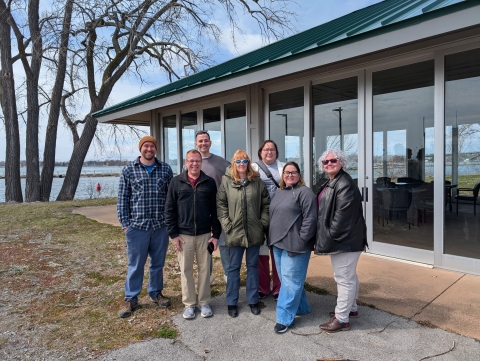
New Website
The GLC website has a new look! Last updated in 2012, it was time for an update. Kit Hastings built the new version, migrating over 150 pages and over 2000 pictures and documents from Drupal 7 to Drupal 10 content management system. The new look launched in January 2025.
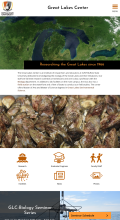
Molluscs through time: Oneida Lake’s 100-year ecological journey
by Alexander Karatayev and Lyuba Burlakova
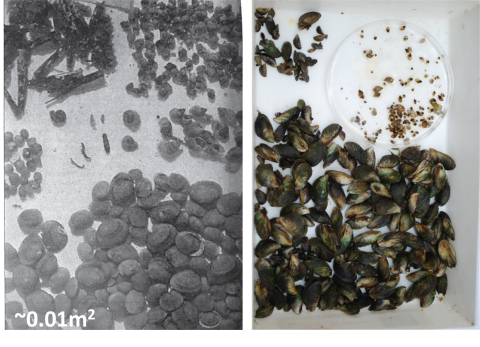
2012 sample (right panel). Baker wrote: “Note the great abundance of the bivalve
mollusc Sphaerium and the gastropod Amnicola.” The formerly abundant large
sphaeriids are now replaced by dreissenids.
Early this year, we published the paper “Multiple invasions decimate the most imperiled freshwater invertebrates” by Alexander Y. Karatayev, Lyubov E. Burlakova, Vadim A. Karatayev, John E. Cooper, and Lars G. Rudstam, in collaboration with scientists from Cornell University and University of Maryland College Park. We analyzed what happened with the molluscan community in Oneida Lake during the last 100 years, using studies in 1915-1917 (Baker, 1916, 1918), 1967-68 (Harman and Forney, 1970), 1992-95 (Harman 1993, 2000), and by us in 2012 (2014) and 2022-23 (2025) (see our article in the Fall 2022 Newsletter).
During Baker’s survey, Oneida Lake was still in pristine conditions with high water clarity, abundant macrophytes and benthic algae, supporting diverse molluscan community of 32 gastropods and 9 unionid species. The mollusc community was almost exclusively represented by the native species with only one exotic gastropod Bithynia tentaculata. Sphaeriids were very diverse, including large species of Sphaerium and Musculium that were never found during later surveys. Increased eutrophication in mid-1900s combined with shoreline development and water level regulation caused strong declines in the water clarity followed by declines in macrophytes. Due to the decline in their primary food source of macrophytes, periphyton, and benthic algae, the formerly diverse and abundant native gastropod community was diminished dramatically. By 1967, the previously abundant Lymnaeidae and Physidae completely disappeared, while the density of exotic B. tentaculata in the Lower South Bay increased 49-fold; there were no changes in the occurrence or diversity of unionids. The introduction of dreissenids was associated with a significant increase in Secchi depth and macrophyte, benthic, and periphyton algae production, all the main energy sources for benthic grazers. In contrast, the overgrowth of unionids by zebra mussels caused their lakewide extirpation in the mid-1990s, and they have not been recovered as of 2023. The arrival of another invasive species, the round goby, in 2014 had a strong negative impact on virtually all gastropod species within the first 2-3 years since their invasion. Being a benthic feeder, the round goby actively feeds on bottom invertebrates including various molluscs, and the observed decline in molluscan density in Oneida Lake was not surprising. However, it was surprising to find a partial significant recovery in most gastropods between years 3 and 7 since the goby invasion.
Therefore, over the past hundred years, the molluscan community of Oneida Lake experienced the effects of eutrophication and multiple invasions, including zebra and quagga mussels and round goby. Overall, the impacts of multiple stressors resulted in declines in species diversity and density of native gastropods and extirpation of unionids and other native clams, Sphaerium spp. and Musculium spp. While at the beginning of the 20th century the density of native molluscs was over 99%, currently the invaders, mainly dreissenids, comprise 89% of density and 99% of wet biomass of all molluscs in Oneida Lake. While individual stressors have taxon-specific and sometimes positive impacts, eutrophication and species invasions have collectively decimated the native mollusc community over the past century.
The echo of two graphs
by Dr. Stephen Vermette and Joel Willis, undergraduate Environmental Geography major
Joel Willis is updating the numbers for the WNY Climate Trend Analysis. Shown are two graphs, one depicting Buffalo’s average annual air temperatures from 1965-2024 (as measured at the Niagara Buffalo International Airport), and another depicting average annual Lake Erie water temperatures from 1965-2024 (as measured 30 feet below the surface at Buffalo’s water intake crib). The year 1965 was chosen as an inflection point where climate forcing dominates temperature trends.
The remarkable similarity between graphs is interesting, especially as related to the time trend. Both air and water temperatures have increased at a rate of 3.3ºF (1.83ºC) since 1965. The year 2024 records the highest temperature for both graphs, with both graphs showing similar increases since 2023 (~1.8ºF).
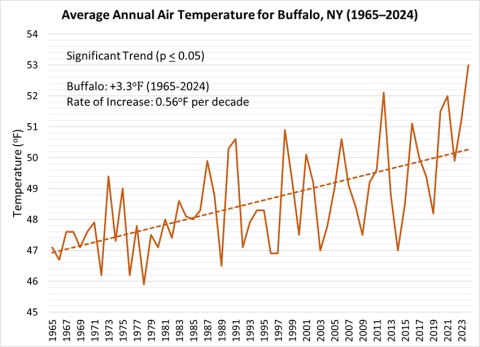
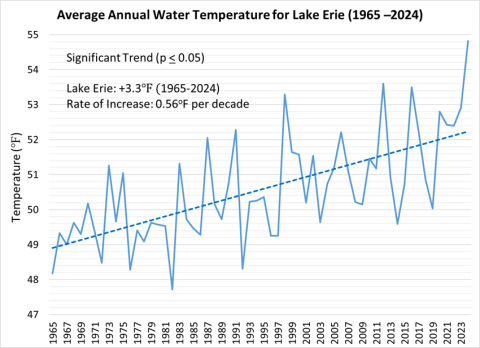
Photos from sabbatical
by Lyuba Burlakova and Alexander Karatayev
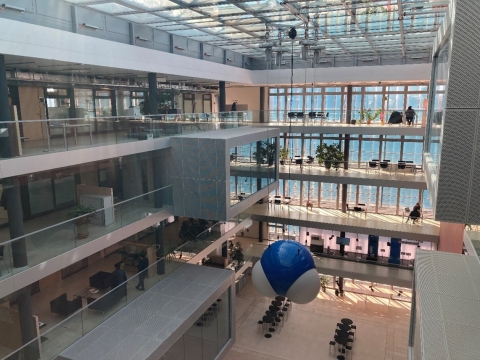
benchmark of sustainable development, operating without the need for
conventional heating and cooling. The electricity is generated solely from
renewable sources, whether from the photovoltaic system on the roof or from the
purchase of certified green energy.
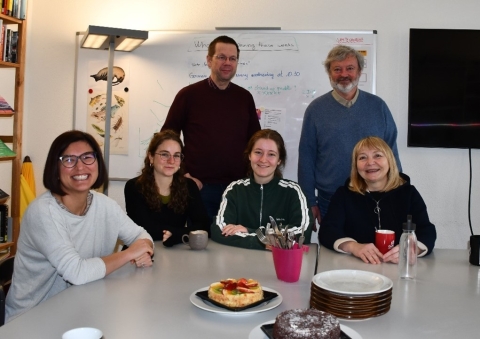
Piet Spaak, Sophie Kessler, Sasha Karatayev, and Lyuba Burlakova.
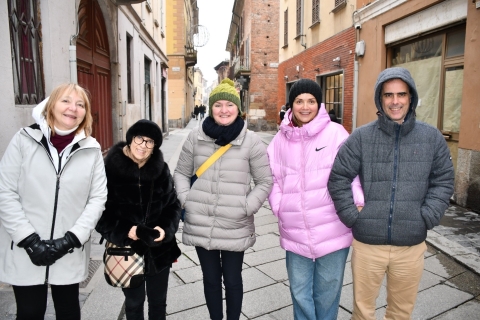
Urbanska), and Portugal (Anabela and Manuel Lopez-Lima) to discuss our future
field trips, conferences, and joint manuscripts.
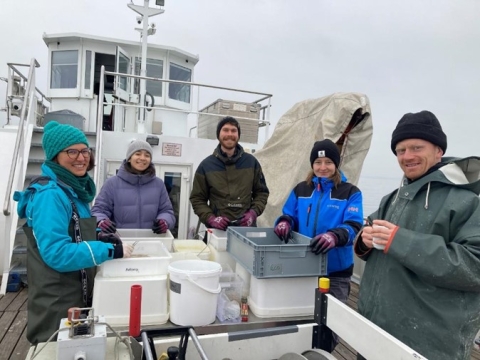
effect of food, temperature and oxygen on mussels that Joana Santos, a postdoc
from our Quagga mussel group, is carrying out this spring.
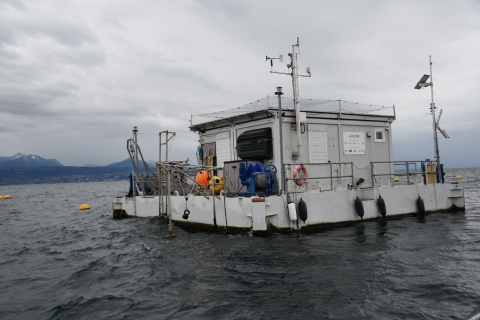
Geneva, we visited LéXPLORE, a floating platform installed on Lake Geneva in
2019 as a joint project of Swiss and French scientists.

discussed future collaboration and presentations at the upcoming 24th
International Conference on Aquatic Invasive Species (ICAIS) that will be held in
Belfast, Northern Ireland, in August 2026.

